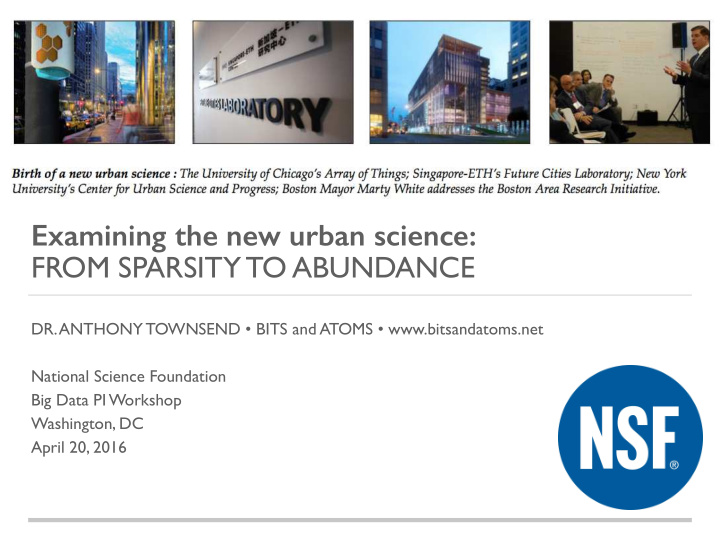



Examining the new urban science: FROM SPARSITY TO ABUNDANCE DR. ANTHONY TOWNSEND • BITS and ATOMS • www.bitsandatoms.net National Science Foundation Big Data PI Workshop Washington, DC April 20, 2016
big urban data is neither new… The Tabularium, Rome 2
one beginning of big data was to measure cities! IBM and the 1890 U.S. Census 3
…nor truly big So big you need me! Too big for me! The Goldilocks Zone (and most big urban data we work with every day) 4
this really is big urban data Living PlanIT (circa 2030): 200,000 people 255 petabytes / year (98 percent is video) LHC (today): peak 10 Gb/sec ~30 petabytes/year
cities of data project: examining the new urban science 2014-2015 at NYU Rudin Center • Support from Data and Society Research Institute, MacArthur Foundation, and Knight Foundation • who? what? where? why? when? how? of data-intensive urban research • special focus on new groups formed outside traditional urban studies, geography, and planning • schools and programs www.citiesofdata.org •
living labs, applied science, and the huge expectations around big urban data research
emerging frontiers • verification of long-standing urban heuristics (e.g. Jane Jacobs was right!) • tiers of sensing: • retail - ‘pedestrian’ sensing (Placemeter + Paris, LinkNYC, Array of Things) • application-specific (e.g. NYC taxi GPS logs) • ‘synoptic’ sensing (Koonin, NYU CUSP) - urban-scale, long-duration, multi-spectral instrumentation • industry-led data mining - (e.g. Sidewalk Labs’ Flow and Google HULK, Foursquare, Facebook migration study • citizen science…
why citizen science? BETTER SCIENCE MORE TRUST IN RESULTS STRONGER PARTNERS FOR APPLICATION
Citizen Urban Science Array of Things
Citizen Urban Science: New Models
The Future of Urban Science — Alternative Scenarios Bubble Integration Enigma Overrun Urban science overshoots Urban science helps engineer Urban science uncovers Urban science does what demand for students, applied a smooth paradigm shift in more questions than it economics did to, well, research, and institutional urban studies and planning, answers by mapping a everything. support - and probably validating and updating old vast unknown territory already has. theories and models. in short order. www.citiesofdata.org
implications and impacts • This is scientifically AND socially important in a way that few research topics are: • Cities are civilization - over the next century global urban population is moving from 3.5 to as much as 8 billion, 50 to 90 percent of total • Perhaps the most important subject of research - we know so little about underlying dynamics, and the lock-in of bad decisions now will be very long as network structures are determined. • Even the most cursory application of models from other fields is yielding huge new insights, and providing formal basis for old intuition • The institutional landscape is forming: • UK Future Cities Catapult - modeled after Germany’s Fraunhofer Institute • Formation of MetroLab in 2015 by White House OSTP Smart Cities Initiative - meeting in 2 weeks in San Diego (metrolab.heinz.cmu.edu) • The U.S. needs to spend $2-3 trillion to maintain infrastructure over the next decade. • Assuming we can apply the resulting knowledge - and that is a big IF based on current work - even just a tiny improvement in the effectiveness of that spending, could be very highly levered investment.
resources www.citiesofdata.org www.datasociety.net metrolab.heinz.cmu.edu www.smartcitiesbook.com slides - https://perma.cc/N938-VPN6
Recommend
More recommend